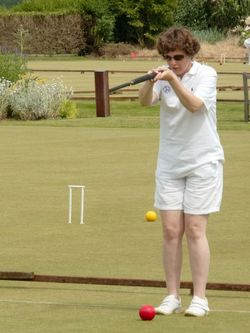 Louise Bradforth, current GB women’s champion, qualified for the main knockout with a 5-5 record. Photo by Eileen Soo. Click to enlarge.Player report from Jeff Soo:
Louise Bradforth, current GB women’s champion, qualified for the main knockout with a 5-5 record. Photo by Eileen Soo. Click to enlarge.Player report from Jeff Soo:
Fifteen players qualified today for the main singles knockout, joining the seven who had qualified yesterday. Tomorrow’s knockout pairings have been posted on the CA Site. One of the more interesting match-ups is Reg Bamford (South Africa, resident in England) vs. Matthew Essick (USA). Bamford, world #3, is the top-ranked player in the tournament, ten-time previous champion as well as four-time world AC champion. Essick, the 17-year-old wunderkind, at world #30 is a decided underdog in this match, but has the skills and temperament to pull off the upset.
PHOTO GALLERY | CROQUETSCORES KNOCKOUT
On Super-Advanced Play
Super-Advanced is an excellent game even outside the top class. The extra lift hoop transforms tactics in unexpected ways. True, there are still games where one player never takes croquet, but these are quite rare. The obvious tactic of taking two breaks with the same ball to get to 4-back is often considerably more challenging than a plain break to 4-back, even if the opponent misses the first lift. Where the players are capable of triple peels, going directly to 4-back (or 3-back) and conceding contact is a strong tactic, adding new challenges in making leaves and picking up breaks. It’s time to give Super-Advanced Play some trials in the US.
UPDATES: DAY 1 | DAY 2 | DAY 3 | DAY 4 | DAY 5 | DAY 6 | DAY 7 | DAY 8 | DAY 9
